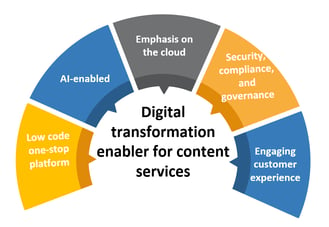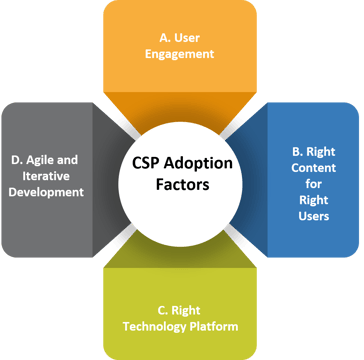Gartner defines a content services platform as “an API centric, cloud/device-agnostic next generation enterprise content management system that supports multiple repositories, endpoints, content types, and business use cases to serve multiple stakeholders across an organization.”
As true as that definition is, it is also equally important that we should assess just how much viability and value such conventional content services provide in today’s digital age. Quite often, long implementation cycles, lack of attention to personalization, regional nuances, unsatisfactory end-user experience, and low adoption render digital collaboration initiatives unproductive.
Organizations now realize that a modern digital workplace is essential towards increasing employee productivity and engagement, resulting in a quantifiable ROI.
As per the current digital business requirements, any Content Services Platform (CSP) should comply with the following goals:

- Low code one-stop platform that enables quick access to complete contextual information, whenever and wherever needed
- Artificial intelligence enabled for content service, classification, productivity, and automation scenarios
- Emphasis on the cloud
- Aligned to security, compliance, and governance standards
- Ease of use to deliver an engaging customer experience
|
As per the global forecast report, the content services platform market is expected to grow from USD 22.6 billion in 2018 to USD 60.3 billion by 2023, at a Compound Annual Growth Rate (CAGR) of 21.7%. |
Moving from Control to Access
Nowadays, businesses are shifting from content control to content access, putting more emphasis on user empowerment, user experience, and user personalization. Many enterprises have content services platforms in place, but most of them use multiple platforms instead of a single one to serve their content needs across channels. Successful content marketing strategies focus on publishing only the relevant content for each country/geography at different stages of the end-user journey.
Organizations looking to set up standardized content services on a large scale should not be reinventing the wheel. Instead, they should follow a clear and repeatable process that delivers high-quality content by implementing the relevant content services ideas/strategies.
Reinventing the Content Services Platform
Setting up the right content services platform is a critical initiative in centralizing access to information with the latest innovations and projects. A robust CSP is vital towards achieving excellence in any organization.
Considering a digitally savvy global population, the following key factors ensure a successful content services platform adoption: 
|
Interesting Facts
Source: Deloitte Global Research
Source: McKinsey Global Institute analysis
|
A. User Engagement
The content services platform must have a strong focus on excellent user experience for continued user engagement and increased traffic through referrals. User engagement can be magnified in the following ways:
- Provide an intuitive, consistent, and delightful user experience for the enterprise.
- Harness omnichannel user engagement through platform integration.
- Give anytime, anywhere access to the users of the platform via a mobile app.
- Implement immersive user experience by enabling platform content visualization through next-generation technologies like AR/VR.
B. Right Content for Right Users
The other key factor is the content provided to the end-users of the platform. The most important things to consider for this are:
- Provide personalized content to the users by sharing what is relevant to their profile, interest topics, preferences, etc.
- Offer contextual content, such as content that is customized and applicable specifically to the user’s location.
- Cater to a global audience by providing a multilingual platform supported with content from multiple regions.
- Set up workflow automation to enable faster content curation and publishing to the end-users.
- Provide personalized access to the content based on each user role - visitor, member, and contributor.
C. Right Technology Platform
Organizations must be supported by the right technology platform that provides:
- Flexibility to support the upcoming content types.
- Extensibility to enable the creation of custom features as per the use case requirements.
- Scalability to sustain any increase in web traffic.
- Robustness to deliver consistent performance, irrespective of the number of concurrent users.
- Ensure secure access to information.
- Easy and quick integration with new applications, social media for sharing content, integration with CRM, if required, for user information, etc.
D. Agile and Iterative Development
It is critical that the platform is not stuck in long development cycles, as they delay end-user rollout. Rollout and development need to be agile, ensuring key aspects such as:
- Iterative development so that a usable version of the platform for the end-users is quickly available at the end of each iteration (short release cycles).
- Prototyping to visualize the platform features being developed and to quickly capture the feedback to be incorporated.
By following these steps, organizations can bring intelligence into their business processes by leveraging the benefits of a digital content services platform. This ensures rapid access to contextual information whenever and wherever it is needed for the creation of content. It also allows for collaboration across the organization and external stakeholders. Take a look at the Gartner magic quadrant to check the leaders of content services platforms and evaluate the one that fits your digital workplace requirements.
You can also use all this information to assess whether your content services are aligned to your digital goals.




